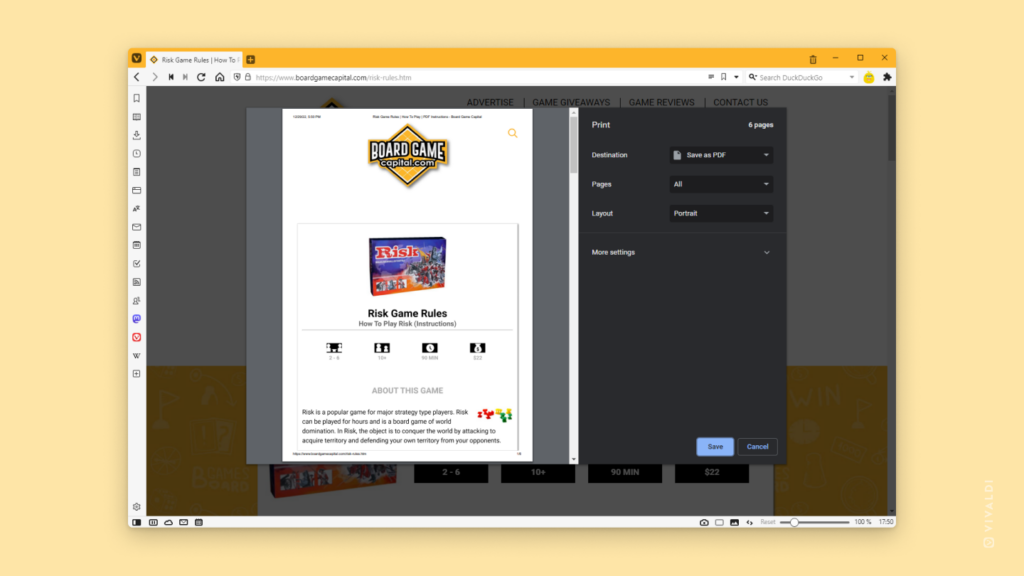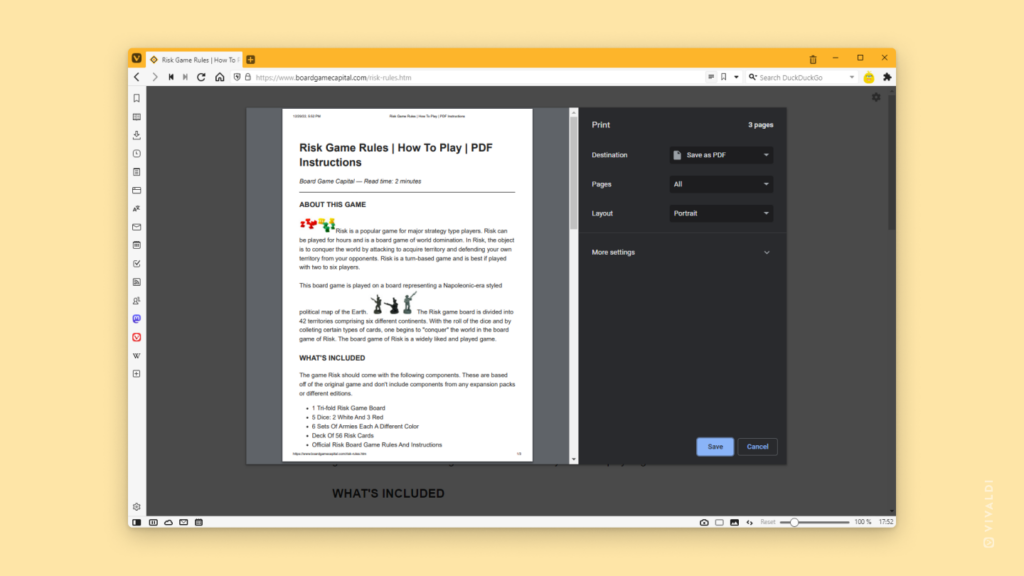Desktop Tips
Tip #196
January 19, 2023
Press Alt+Enter to open a link or a search entered in the Address Field in a new tab.
When you’ve typed something in the Address Field, but then decide that you also want to keep the current page open, hold down the Alt key while pressing Enter and the link or search results will open in a new tab.
Tip #195
January 18, 2023
If a web page doesn’t load properly, try reloading it without cache.
Browsers save some website data to make them load faster when you visit the page again. If you notice that a page you’ve visited before doesn’t load properly, you can try loading the page again without the stored cache, also known as a hard refresh or reload.
To load a page without cache, use one of the following Keyboard Shortcuts:
- Windows and Linux –
Ctrl+Shift+RorCtrl+F5 - macOS –
⇧⌘Ror⌘F5
Alternatively, type “Force Page Reload” in Quick Commands.
Tip #192
January 13, 2023
Pay attention to incoming emails and don’t get scammed.
We’ve listed a few tips below to help you be vigilant and not fall for email scams.
- Look at the sender address. Be suspicious of email addresses containing misspellings, ones that are just made up of gibberish or do not look related to the sender they claim to be.
Also, be cautious when there’s a different Reply-To address, especially if it matches the descriptions above.

- Pay attention to message content. If what the message promises is too good to be true, it’s probably not true (e.g. claiming you inherited or won a large amount of money).
Also, when an email, seemingly from a reputable company, is written with poor grammar or your acquaintance writes in a style unusual for them, look for other clues.
Be suspicious of emails that create urgency and ask you to act fast. - Don’t trust emails that ask for your personal information (ID number, bank account details, etc.). If you think that a reputable institution is asking you to update your personal information, don’t follow the links in the email, but go to their website directly to check your account.
- You might be asked to visit a link. Don’t blindly open them. Hover over the links and check the browser’s status bar to see where it wants to take you.

- If you don’t fully trust the sender, don’t open files attached to the email.
- Use other means of communication to verify that the person or company really sent the message. For example, if a colleague asks you to do something (share a password, purchase something, etc.) via email, call them or ask them in person, whether they really made the request.
Tip #191
January 12, 2023
Take your notes to the next level by adding image attachments.
“A picture is worth a thousand words”, as the saying goes. So, instead of making long notes with just text, add an image to make the message clear.
To add an attachment in Notes:
- Open the note either in the Notes Manager or Notes Panel.
- In the Notes Manager, click on Attachments > Add Attachment on the notes editor menu. In the Notes Panel, click on the
 Attachments icon.
Attachments icon. - Locate the image file in your File Explorer/Finder and click Open to add it.
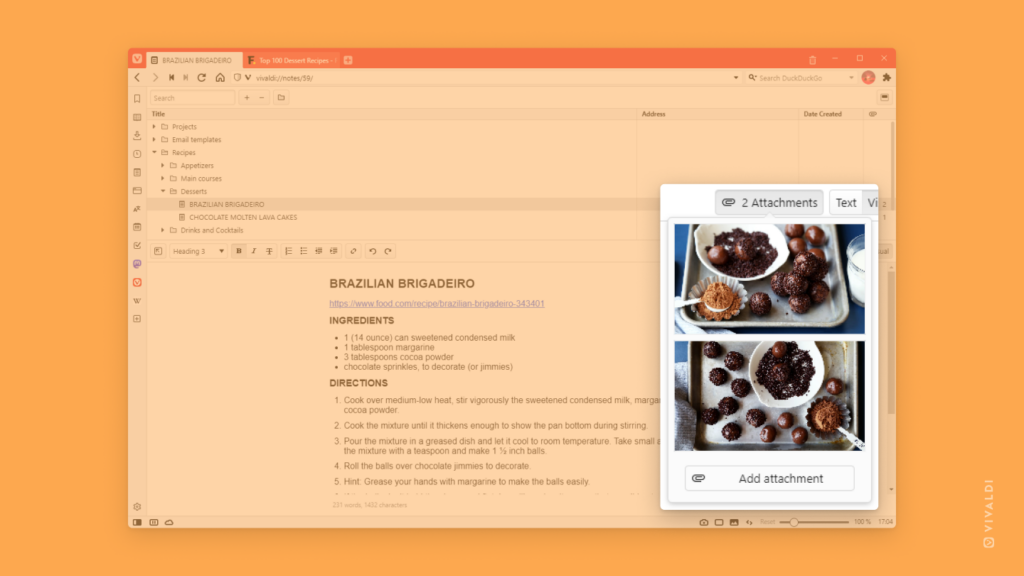
Tip #190
January 11, 2023
Enable search suggestions to get suggestions from the search engine as you type.
Search Engines can show you suggestions as you type the search query in the Address or Search Field. It can make searching faster. The way it works, however, is that everything you type is sent to the search engine. Since it can be quite revealing, in Vivaldi, the setting to show suggestions is not enabled by default. But since we are all about giving users options, you can choose to enable it if you prefer convenience over privacy.
To enable search suggestions:
- Go to Settings > Search > Allow Search Suggestions.
- Depending where you want to get suggestions, enable the setting for the Address Field and/or the Search Field.
In the Address Field, to limit what you type from being sent to the search engine, you can enable suggestions to be shown only when you first enter the Search Engine Nickname.
Read more about Search Suggestions and their privacy implications on our blog.
Tip #189
January 10, 2023
Mark incoming Mail messages automatically as read.
Not all messages you receive are equally important. For example, you might be subscribed to updates or newsletters that are good to have, but don’t need immediate attention. Having less unread messages is less intimidating and important messages will be more noticeable.
To create a filter in Vivaldi Mail to mark messages as read:
- Go to Settings > Mail > Mail Filters.
- Click
 Add Mail Filter at the bottom of filters list.
Add Mail Filter at the bottom of filters list. - Give the filter a name.
- Define the criteria for filtering. For example, all emails with a certain subject or all emails sent from a specific email address.
- Click Add to Search.
- If you wish, add additional criteria.
- Click Add Action.
- Select Mark as read.
- Click Add Mail Filter.
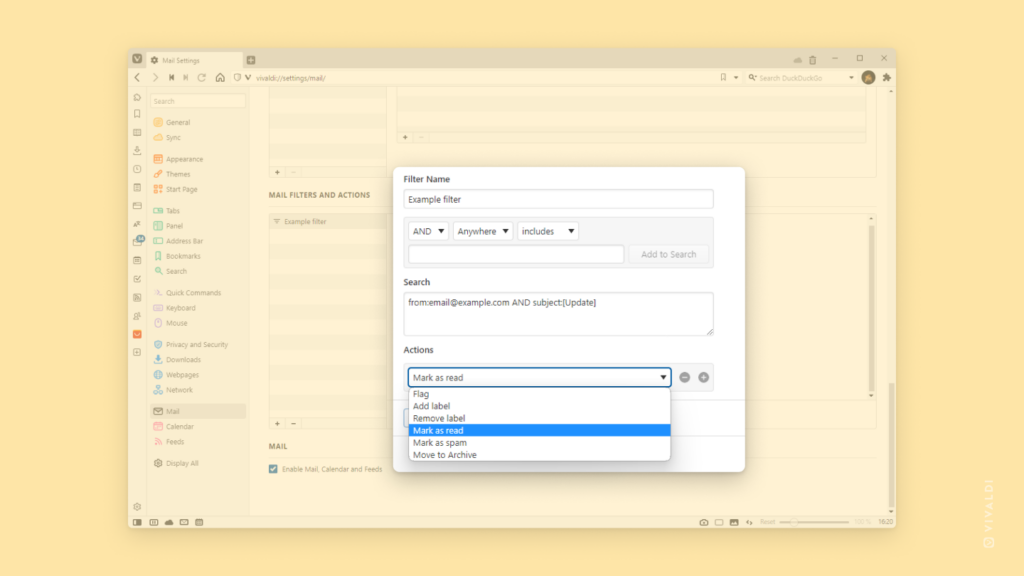
Tip #188
January 9, 2023
Create independent apps from websites by installing them as Progressive Web Apps.
If you like to use web services in their own app, give Progressive Web Apps (PWA) in Vivaldi Browser a try. They can be opened from shortcuts and used in their own window separate from the main browser.
To install a website as a PWA:
- In a tab, open the website you want to install.
- While the site is open in the active tab, right-click on the tab on the Tab Bar.
- Select Install [website name] from the context menu.
- Click Install in the small pop up asking you to confirm your action.
In case you don’t see the option to install the website in the context menu, the website doesn’t support running as a PWA. In that case, while the site is open in the active tab:
- Choose Create a shortcut from the context menu instead.
- Tick the box for Open as Window.
- Click Create.
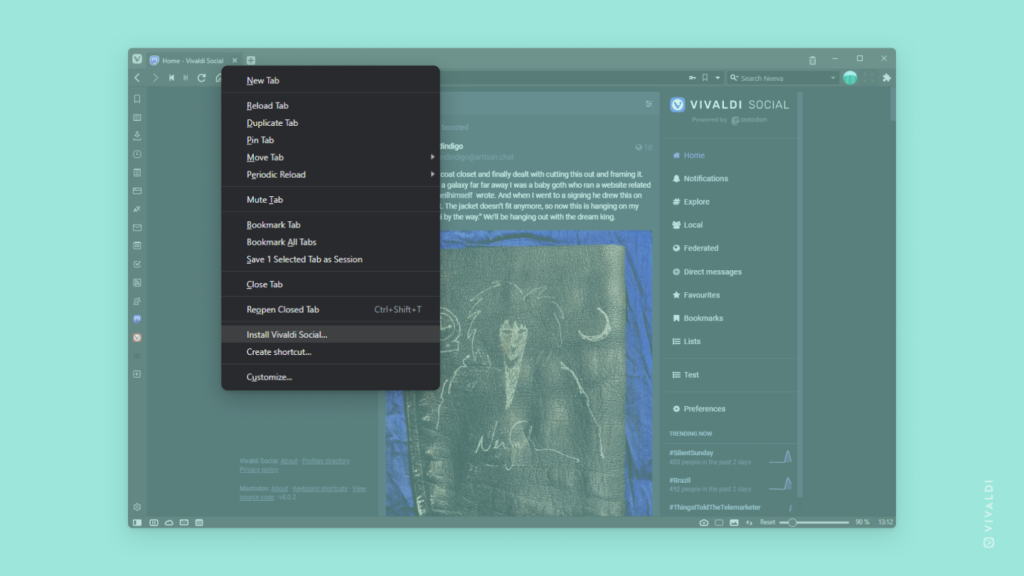
Tip #186
January 5, 2023
Add a new folder to your mail account from the Mail Panel.
Messages can be organized using Filters, Flags and Labels, but the classic option is folders. You can add new folders in the email account’s web interface or in a client where the account has been set up.
To add a new IMAP folder in Vivaldi Mail:
- Open the Mail Panel.
- In All Accounts section, right-click on the account you want to add the folder for.
- Select Create Folder from the context menu.
- Give the new folder a name.
- Click Create Folder.
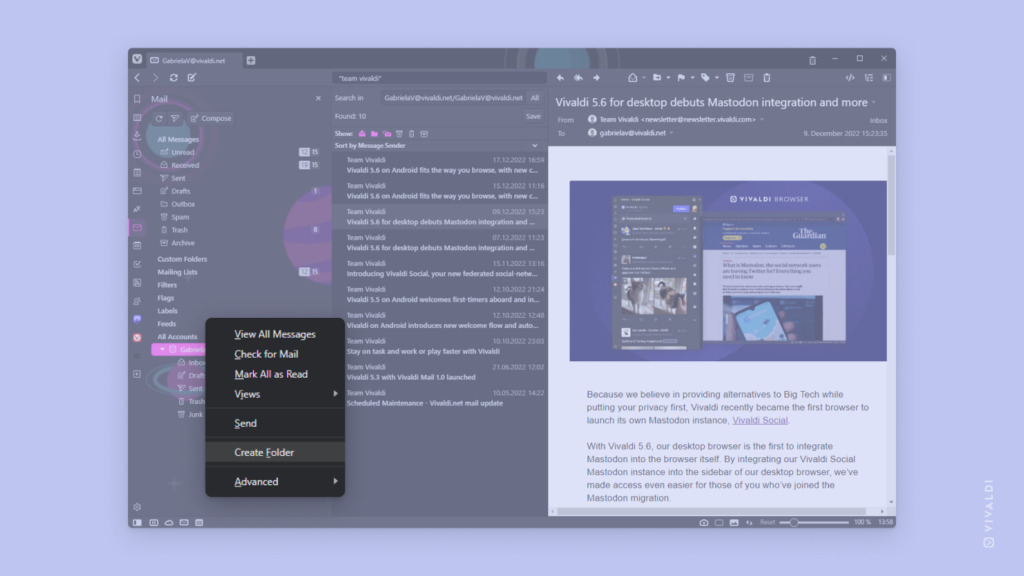
Tip #184
January 3, 2023
Hover your mouse over the Tab Bar and scroll to switch tabs.
In Tip #53 we told you how to switch tabs with right-click and scroll. In this post we’re sharing another tab switching option using your mouse’s scroll wheel.
To use the feature:
- Go to Settings > Tabs > Tab Features > Tab Cycling.
- Enable Switch Tabs by Scrolling.
To switch tabs:
- Hover your mouse cursor over the Tab Bar.
- Use the mouse’s scroll wheel to go through the list of open tabs.
Tip #183
January 2, 2023
Combine Vivaldi on Windows with Razer Chroma to make browsing more immersive and personal.
If Santa brought you new Razer Chroma gear for your computer, you can include Vivaldi in the color play. When Razer Chroma devices have been connected, your Theme‘s accent color will be reflected on the devices.
To enable Razer Chroma integration:
- Make sure your Chroma devices are connected to your computer.
- Go to Settings > Themes > Razer Chroma Theme Integration.
- Click Enable Razer Chroma Integration.
- Select the devices you want to sync with Vivaldi.
Make it more fun by enabling Accent from Page in your active theme’s settings or by setting up theme scheduling.
Tip #182
December 30, 2022
Follow accounts on Vivaldi Social and other Mastodon instances with Vivaldi Feeds.
If you don’t feel like going to Mastodon regularly to see what people you like post, you can have their posts come to you in the Vivaldi Browser by subscribing to their content with Vivaldi Feeds.
To add a Mastodon account to Vivaldi Feeds:
- Open the profile of the account you want to follow. Make sure the profile is open on its own instance. It’s not possible to subscribe to a feed when viewing it through a different instance.
- In the Address Field, type
.rssat the end of the URL. - On the feed preview page, click Subscribe.
- If you wish, update the feed title and refresh interval.
- Click Add Feed.
Tip #181
December 29, 2022
Enable Reader View before printing to remove the clutter and print only the important content.
Many websites, especially news sites, strip the printable page of irrelevant content. In case the web page you’re trying to print doesn’t do that, you can switch to Reader View, which will remove unnecessary sections and lets you print just the article. In addition, by using Reader View, you can adjust the font, font size, and line height before printing.
Here are the steps:
- Open the page you want to Print.
- Enable
 Reader View from the button on the right side of the Address Field.
Reader View from the button on the right side of the Address Field. - If needed, adjust the text from
 Reader View settings in the top right corner.
Reader View settings in the top right corner. - Open the Print menu from
 Vivaldi menu > File > Print (Ctrl + P / ⌘ P).
Vivaldi menu > File > Print (Ctrl + P / ⌘ P). - Review print settings.
- Click Print.
